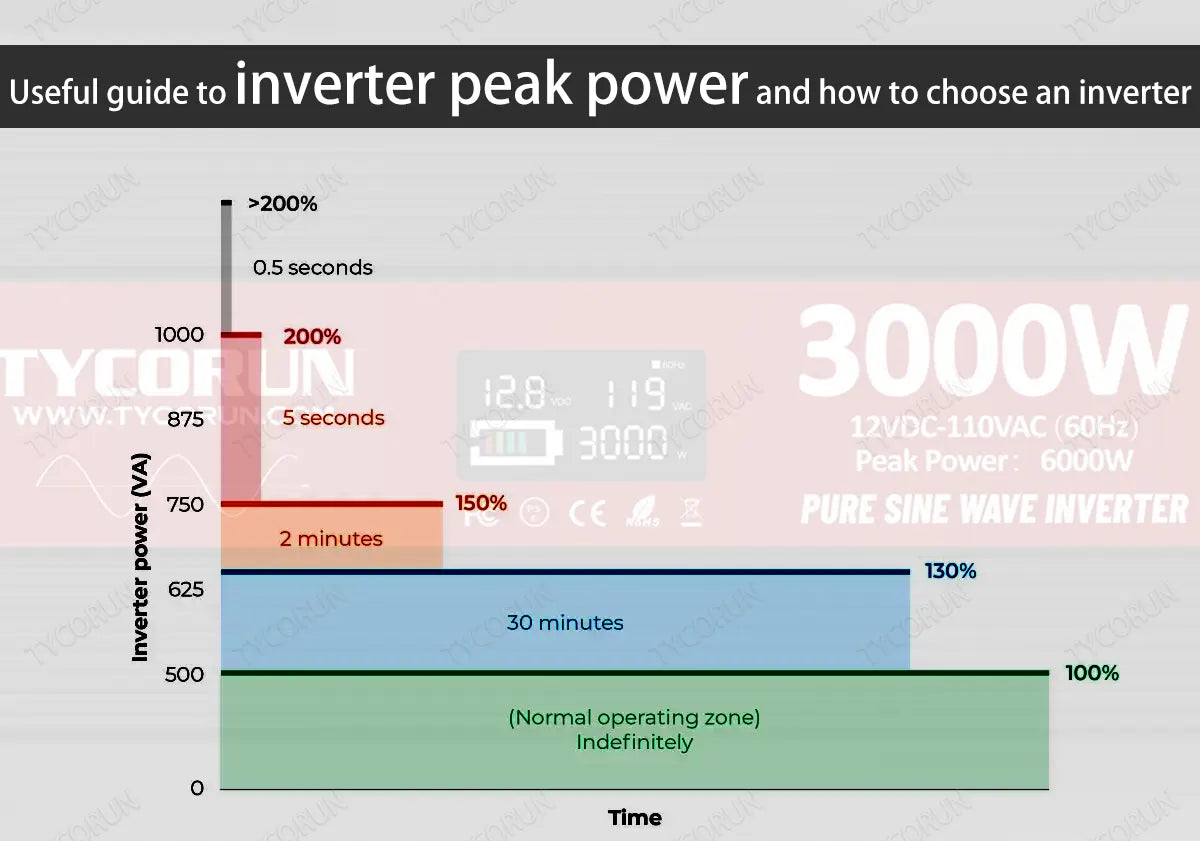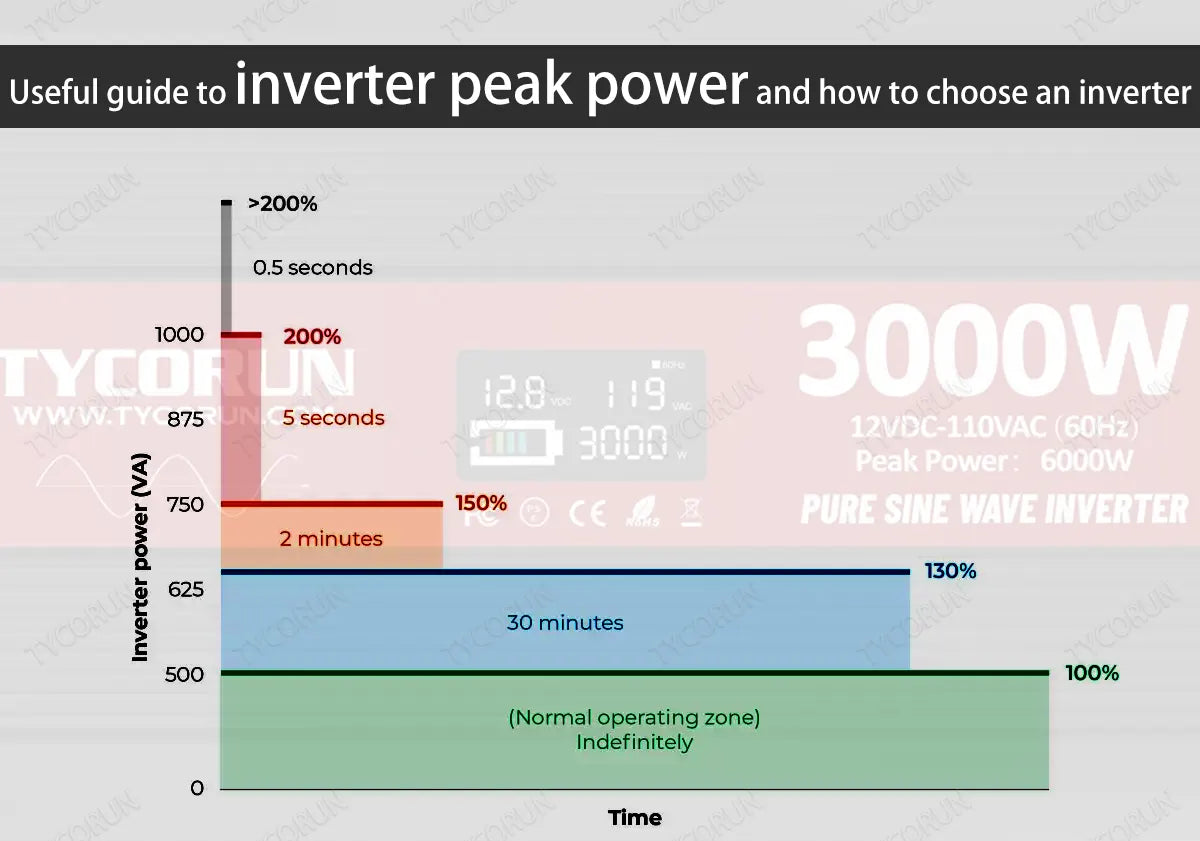
Power inverters come in many specifications, which usually include rated power and inverter peak power. Rated power is continuous output power, which refers to the power that the inverter can keep working for a long time. Inverter peak power also means the starting power, which is generally twice the rated power, mainly used to meet the instantaneous peak value when individual household appliances are started.
Therefore, for an inverter, the inverter peak power must be able to meet the instantaneous power when the home appliance is started to ensure normal operation.
Main content:
1. What is inverter peak power
Peak power, also called peak surge power, refers to the maximum power that the power supply can achieve in a short period of time, which usually only lasts about 30 seconds. Under normal circumstances, the peak power of the power supply can exceed about 50% of the maximum output power.
Since the energy required by the hard disk in the startup state is much greater than that in normal operation, the system often uses this buffer to provide the hard disk with the current required for startup. It will return to the normal level after startup to full speed. The power supply generally cannot works stably at peak output. So is inverter peak power a meaningless parameter? No!
Some appliances start with several times the power required for normal operation, but only for a short period of time. The purpose of inverter peak power is to ensure that the power inverter can handle the peaks of such appliances and protect the power inverter, thereby preventing the peaks from damaging the power inverter.
When selecting a frequency converter, and when determining how large a power inverter is required, it is important to distinguish the difference between rated power and inverter peak power. The reference value for rated power will be larger. The rated power is the continuous output power of the inverter, which is long-term and stable power. It provides continuous power for the normal operation of your load.
One thing to note is that if your appliance is an inductive load with a motor (such as a refrigerator, washing machine, electric drill, etc.), you must consider the inverter peak power when choosing an inverter. Because these inductive loads require a large current to start at the moment of startup, the appliance can start normally only when the inverter peak power is greater than the starting power of the appliance. Under normal circumstances, the peak power is equal to 2 times the rated power.
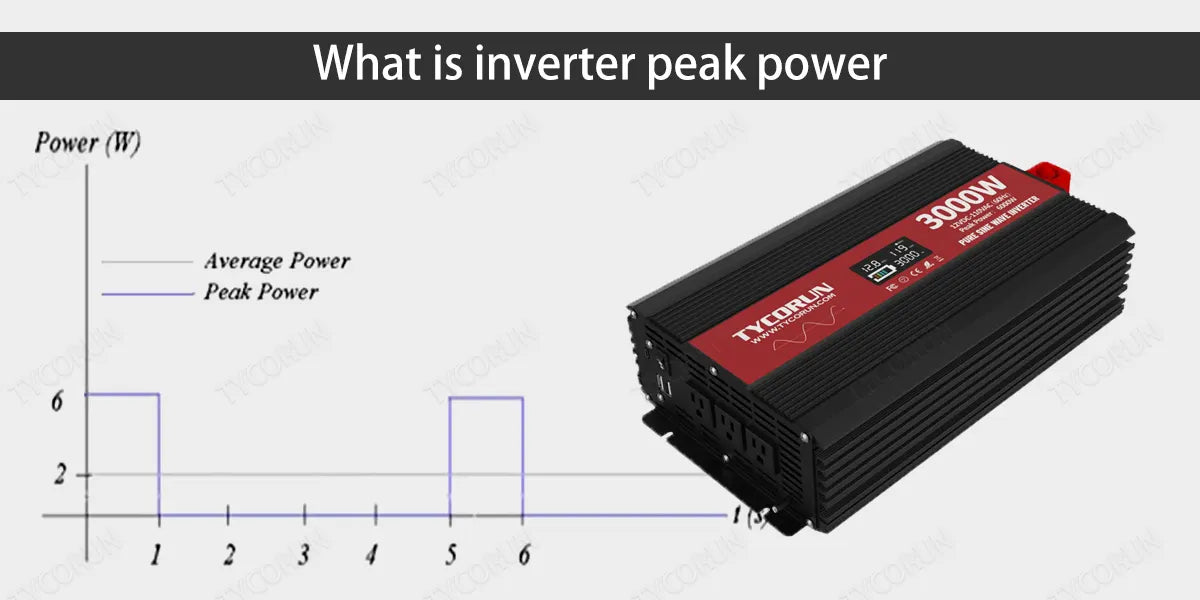
2. Different types of load
Electrical appliances, in terms of technical performance, can be roughly divided into three categories: capacitive electrical appliances, inductive electrical appliances and resistive electrical appliances.
- Capacitive load:
Capacitive, that is, relative to the power supply, the input is a capacitive load. For example, those appliances commonly seen in households: TVs, computers, mobile phone chargers, etc., that are powered by switching power supplies, because the first input stage of such electrical appliances has a large filter capacitor.
The capacitor is connected, but the capacitor current is 90 degrees ahead of the voltage, which means that it is a short-circuited wire relative to the power supply at an instant. Therefore, there is an instantaneous inverter peak power value in this type of electrical appliances.
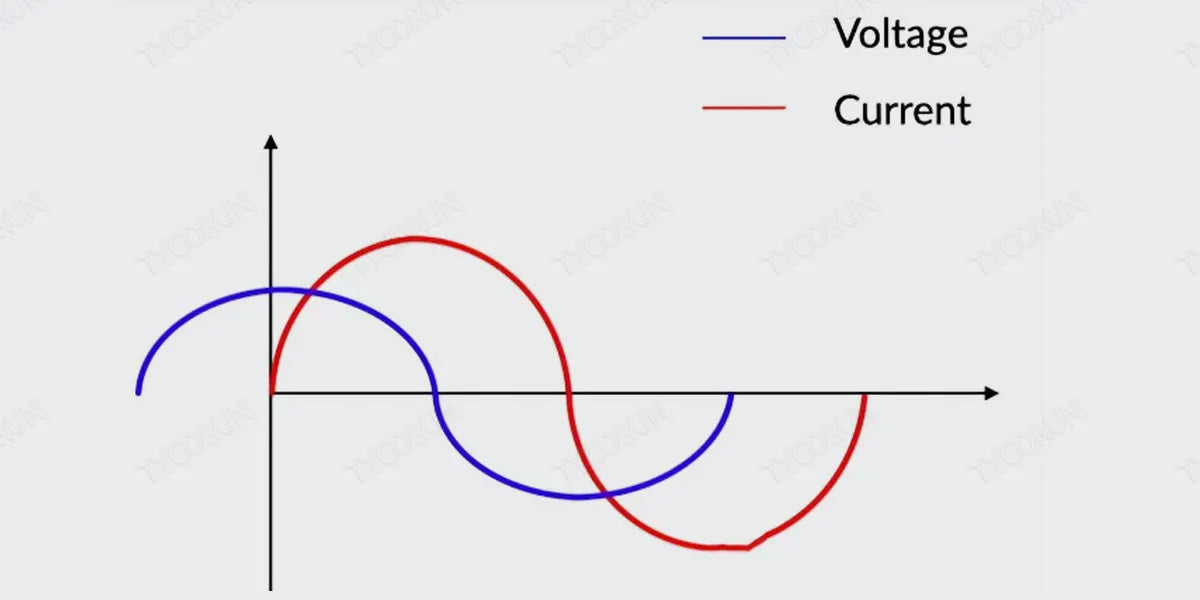
- Inductive load:
A load that only consumes reactive power is called an inductive load. For example, fans, speakers (which are generally powered by low-frequency transformers), water pumps, electric drills, air conditioners, refrigerators, and so on. Its input is relative to the power supply.
It is connected to an inductor coil, and the coil is an inductor. The voltage of the inductor is 90 degrees ahead of the current, which means that it is short-circuited compared to the power supply when it is turned on instantly. Only after starting, the impedance rises, will it run stably.
When we use a high-power motor, we can clearly feel that the entire house's lamps and electrical appliances flash when it is turned on. This is the peak power. The instantaneous peak power is many times greater than the power marked on the motor. For example, for a 500W motor, 3 times the instantaneous starting power is required, which is equivalent to a inverter peak power of 1500W.
- Resistive load:
The most common one is the light bulb. Compared to the power supply, it is a pure resistor and there is no problem of startup shock.
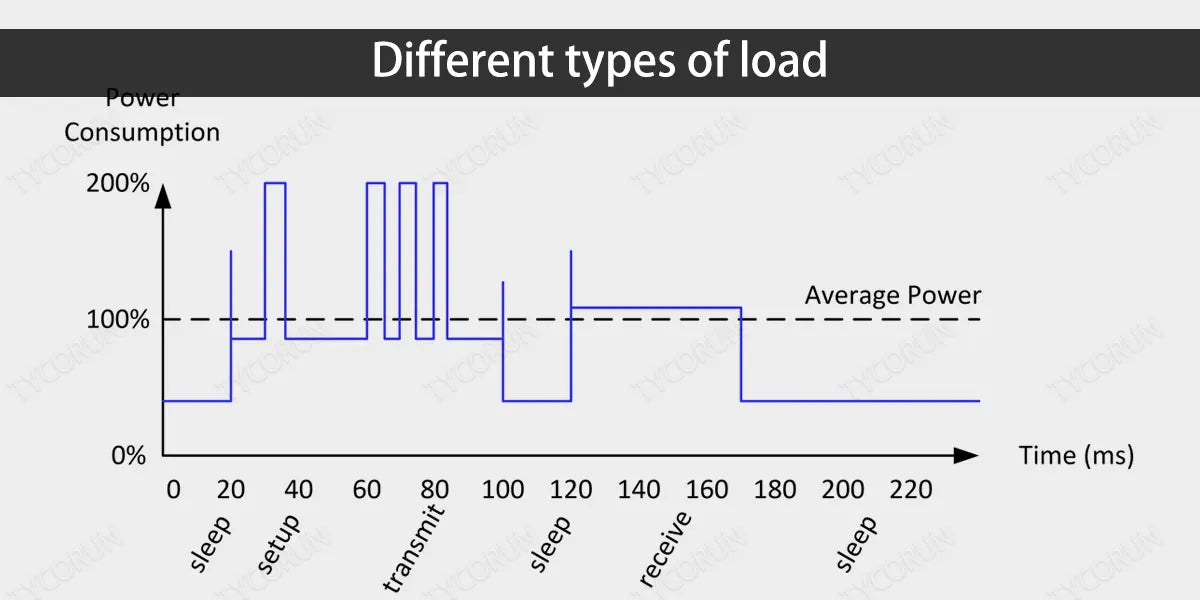
3. How to choose an inverter according to peak power
The inverter must use metal housing. Due to the large power of the vehicle-mounted inverter, the heat is also large. If the internal heat cannot be dissipated in time, the life of the components will be affected, and there is even a risk of fire at worst.
The metal shell has good heat dissipation properties on the one hand and will not burn on the other hand. It is best not to use products with plastic shells. Even if a fan is added to help dissipate heat, firstly, the noise during use is increased, and secondly, the working life of the fan is generally relatively short, which reduces the reliability of the entire machine.
When choosing an inverter, its power should be higher than the starting power of the household appliances used. This is because of the impact capability of the appliance at the moment it is turned on. The impact only appears on inductive or capacitive appliances. For example, for motors, because they are inductive, the impact is generally 3 to 7 times the rated power. For a 500W motor, the power impact is between 1500W and 3500W.
Inverters generally have inverter peak value that is 2 times the rated power, that is to say, a 500W inverter has an instant power output of 1000W, and a 1000W has a peak output of 2000W. But on the other hand, it does not mean that all motors have 7 times the peak value.
We only need to understand that the inverter can instantly output 2 times the nominal power, and the instantaneous start of a capacitive or inductive load requires 3 to 7 times the peak power. How to determine whether it is 3 times or 7 times the peak value? It's actually not that difficult. Appliances of no-load operation needs 3 times inverter peak power value, and full-load operation ones need 7 times, so the peak number can be judged based on the motor drive load level.
- Hand drill:
For electric hand drills, we can only start drilling after the no-load operation is stable, so the peak value is small, so we can calculate it as 4 times the peak value (actually 3 times is enough, and the extra 1 time is the margin). For a 500W electric hand drill, the inverter peak power value should be 2000W, so you can choose a 1000W inverter.
- Air conditioner:
For air conditioners, which are purely inductive, and the starting peak is very large, because every time the compressor starts, the motor works at full load. We can think of it as starting at 7x peak. An air conditioner needs 1000W, and the peak power is 7000W. The inverter needs 2 times the peak value, which means the rated power of the inverter should be at least 3500W. That is to say, an air conditioner with a power of 1000W needs an inverter with an inverter peak power of more than 3500W to start.
Nowadays, all air conditioners are equipped with inverters. We can calculate it as 4 times the peak value. A 1000W inverter air conditioner with a peak value of 4000W needs a 2000W inverter to operate safely. So with a 1000W air conditioner, we can choose an inverter between 1500W and 2000W.
When working, the inverter itself consumes part of the power. Its input power is greater than its output power. For example, if an inverter inputs 100 watts of DC power and outputs 85 watts of AC power, its efficiency is 85%. If the starting power of the motor is 1500 watts, and the inverter peak power is only 1500 watts, there is an efficiency loss during the conversion process, so the required power is not actually achieved. Therefore, you should leave a large margin when purchasing.

- Light bulb:
If it is a purely resistive electrical appliance such as a sun lamp or light bulb, divide the power indicated on the electrical appliance by 0.9. For example: for a 100W light bulb, 100÷0.9=111. So with a 120W inverter, the light bulbs can be used normally.
If it cannot be driven, it means that the power indication of the inverter is actually untrue. According to the inverter standards, if the actual output power reaches 90% of the nominal power, it is a qualified product. For example, a 500W inverter should be able to drive at least a 450W light bulb.
- TV:
There are two types of TVs, one is LCD TV and the other is CRT TV. For LCD TVs, the inverter should be twice the standard power of the TV. For example: the standard 100W LCD TV can be used with a 300W power inverter.
For CRT TVs, because of the large capacitance, the degaussing coil is equivalent to an inductive load, and the impact force is very strong. It is generally calculated as 10 times the peak value. For example: for 100W appliance, the peak value is 1000W, and we need to equip an inverter with more than 500W to drive it.
- Computer:
If it is a computer with an LCD, you should choose the standard power (computer host power) plus 90W. If it is a CRT monitor, you need to calculate the peak power plus 90W based on the nominal power of the selected monitor (the host power is generally within 90W).
- Pump:
A household 500W water pump, calculated based on 7 times (it pumps water as soon as it is turned on, and can only work at full load, with a large peak value), requires an 1800W inverter with inverter peak power value of 3500W. The 750W pump must be equipped with a 2500W inverter to operate safely.
- Car:
Generally speaking, most passenger cars use 12V battery and trucks use 24V battery. When choosing a car power inverter, please pay attention to purchasing an inverter suitable for battery parameters. The car battery voltage must be consistent with the nominal DC input voltage of the inverter. For example, a 24V inverter must be matched to a 24V battery.
Related posts: Top 10 solar inverters, RV inverter, car inverter near me


